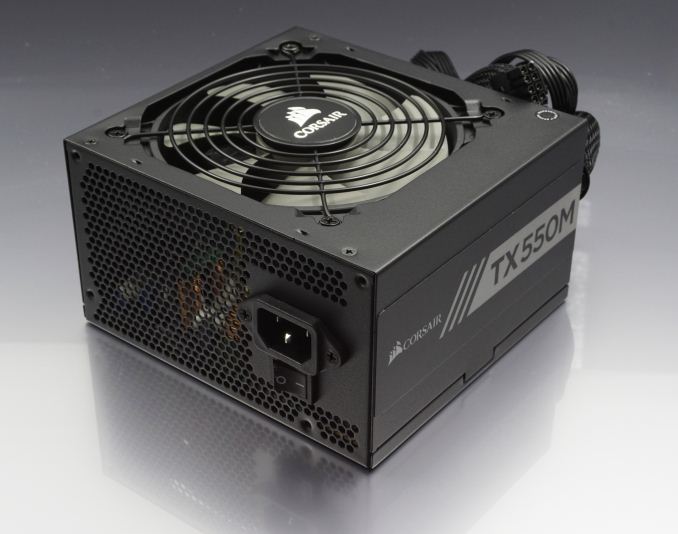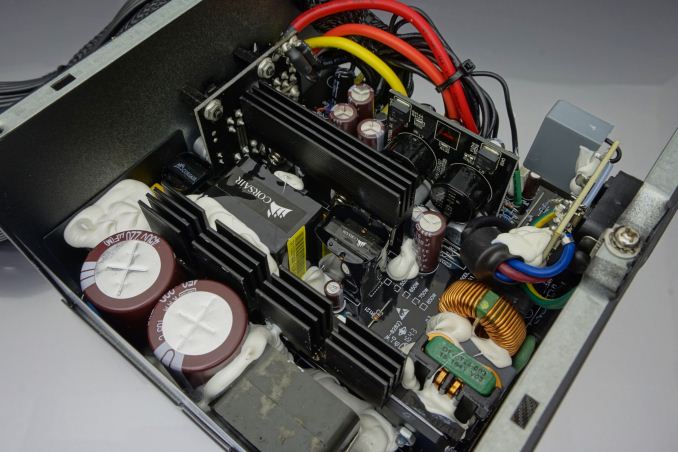The $80 Power Supply for Almost Everyone: The Corsair TX550M 80Plus Gold PSU Review
by E. Fylladitakis on December 1, 2017 8:00 AM EST- Posted in
- Cases/Cooling/PSUs
- Corsair
- PSUs
- 550W
- TX
- Modular
- Power Supply
Conclusion
With the TX-M series, Corsair is trying to fill the gap between its low-cost products and the high performance HX/AX series. The TX-M PSUs are designed to entice the average user who wants something better than a basic model, yet without having to break the bank in order to obtain it. Today we reviewed the least powerful model of the series, the TX550M. As its name implies, the TX550M has a maximum power output of 550W, which is more than adequate for typical single-GPU gaming/workstation systems. It is rated for continuous operation at 50°C and comes with an 80Plus Gold efficiency certification.
The Corsair TX550M is based on a platform by Great Wall, a Chinese OEM, which Corsair has been cooperating with for several of their PSUs over the past few years. This is the most advanced version of this platform that we have seen to this date, boosting the efficiency (just) enough for the PSU to earn an 80Plus Gold efficiency certification. Corsair’s optimizations did not stop there, as their engineers also managed to significantly improve the power quality of the PSU, resulting to low ripple/noise levels for a PSU of this class. The voltage regulation also is very good. Overall, the electrical performance of the TX550M is excellent for a “mainstream” PSU.
On the other hand, the thermal performance could use a few upgrades. The TX550M is neither too hot or too loud - just unsophisticated. Its thermal control feels archaic by today’s standards, when it could have a more powerful fan paired with a start/stop function, allowing it to operate fanless when possible but also keep the temperatures low when needed. The TX550M however is using the fan all the time, even when it does not really need to, making the PSU audible when it could be entirely quiet. On the other hand, the mediocre fan can barely provide enough airflow to maintain safe operating temperatures under adverse environmental conditions. Overall, the thermal control of the TX550M certainly works, but it could do much better.
Aesthetics are a subjective matter, but making the TX series aesthetically unique or attractive clearly was not Corsair’s focus. Unlike the more expensive PSUs of the company, the TX-M does not feature a custom chassis with chamfered edges and other aesthetic improvements. It is using a typical ATX steel chassis, with its only aesthetic improvements being a matte black paint and a semi-modular design. In terms of quality, Corsair is using components only from renowned manufacturers and we also found the assembly job of the TX550M to be excellent. It is no chance that the company is covering the latest TX-M units with a seven year warranty. The TX550M is a PSU designed to reliably serve for many years.
Summing up the above, the TX550M is a very reliable PSU with good electrical performance, making it an ideal choice for users who want to power a typical single GPU gaming/workstation system and have no need for extra/exotic features. Its current retail price of $80 is reasonable, yet it can be frequently found on sale for less than $70 (the 650W version is on sale for $74 at the time of this review), offering an outstanding value-to-performance ratio and long-term reliability.












42 Comments
View All Comments
Yuriman - Friday, December 1, 2017 - link
I'd argue that most home PCs without discrete graphics card are more in the 125-175w range, and many of those with lower end discrete cards (e.g. 1050 Ti) are still coming in under 200w, yet it's rare to find any company offering power supplies that cater to this market. Maybe the casual-use desktop is dead in the ATX form factor? Is everyone using NUC / micro PC / laptops instead?Yuriman - Friday, December 1, 2017 - link
I can't imagine power supplies being particular efficient in machines which idle at 5% of their total capacity, and torture test at less than 40%.A5 - Friday, December 1, 2017 - link
To answer your last question - yeah, the casual-use desktop is basically dead for home users. The big OEMs all still make some for businesses and the few people who want them, but they also right-size the PSUs on custom-order.Jhlot - Friday, December 1, 2017 - link
Exactly I am a light gamer (1050 Ti class) at this age and with time constraint of having young kids. I want a gold rated modular 300w supply at a reasonable price. They don't exist.leetcrew - Friday, December 1, 2017 - link
why even care about the efficiency rating on such a low draw machine? the difference between base 80plus and 80plus gold is 10% efficiency at 50% capacity. this is a delta of ~20W at load. if you live in the US, you would have to play for ~400 hours before you paid another dollar on your electric bill.t.s - Saturday, December 2, 2017 - link
Well, he is not like you sir. And I glad we still have someone like that around.DanD85 - Friday, December 1, 2017 - link
Because the maximum efficiency of a psu can only be reached when it runs at 50% load.Yuriman - Friday, December 1, 2017 - link
A 65w CPU + 75w video card + system components would be just over 50% load for a 300w unit when loaded. Case in point, my 5 year old Core i5 system with 1050 Ti draws between 150 and 175w while gaming.StevoLincolnite - Saturday, December 2, 2017 - link
Don't forget that Ram, Motherboard, Hard/Optical drives, USB devices and so on all consume power as well.t.s - Saturday, December 2, 2017 - link
Don't forget that Ram, Motherboard, Hard/Optical drives, USB devices and so on all consume < 30 watt.